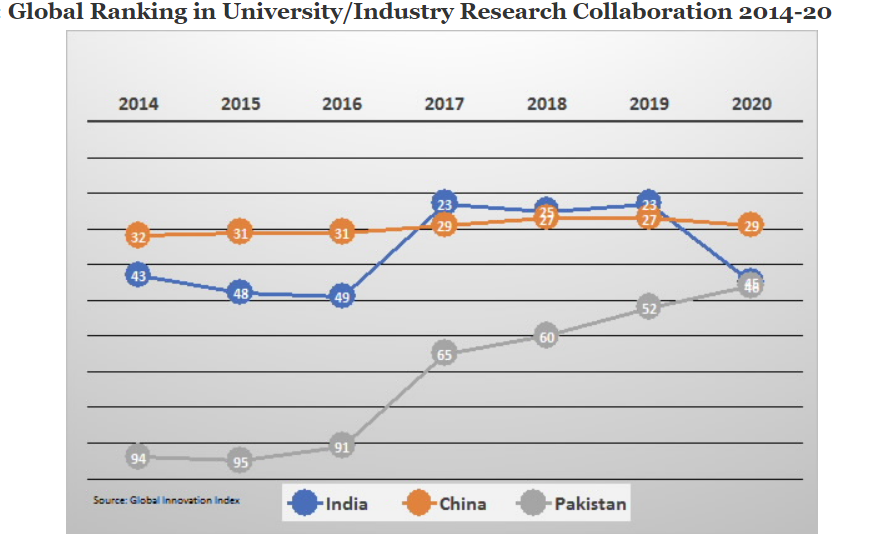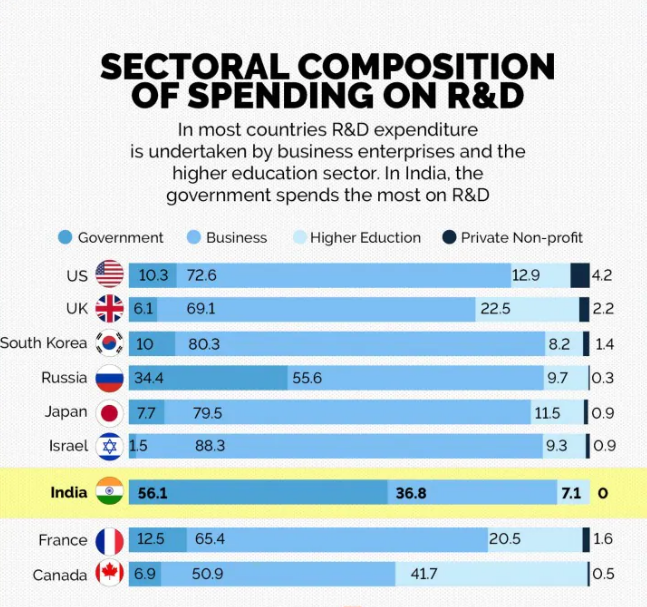Governance
Strengthening the Industry-Academia Collaborations
- 01 Dec 2023
- 11 min read
This editorial is based on “How universities and industry can collaborate” which was published in The Hindu on 30/11/2023. It talks about the benefits and hurdles of industry-academia collaboration and suggests a holistic approach for proficiently addressing these aspects.
For Prelims: Higher education institutions (HEIs), Scheme for Promotion of Academic and Research Collaboration, Impacting Research Innovation & Technology, Uchhatar Avishkar Yojana, National Council for Cooperative Training, India Innovation Growth Programme, Research Park, Sustainable and Vibrant University-Industry Linkage System for Indian Universities
For Mains: Need for Industry-Academia Collaboration, Impediments to Industry-Academia Collaboration, Government Schemes for Industry-Academia Collaboration, Steps ahead for Industry-Academia Collaboration.
“The correlation and collaboration between society and education are so complex that simplified explanations cannot possibly give an adequate account of them. This remark is valid for the tasks which education assigns to society and society to education reciprocally.” -The UNESCO Report,1997on ‘ Learning to Be’
While collaborations between industry and academia are recognized for mutual benefits, many Indian higher education institutions (HEIs) neglect industry partnerships and the potential of intellectual property (IP) and technology transfers, missing opportunities for gains from patents, licensing, and start-ups despite actively conducting basic research.
Effectively overcoming challenges in industry-academia collaborations requires a thorough and multifaceted approach.
Why is Industry-Academia Collaboration Important?
- Practical Expertise and Academic Rigor:
- Industry-Academia collaboration provides organizations with a blend of practical expertise and academic rigor.
- Industry professionals contribute first-hand knowledge of contract administration challenges, while universities offer research-based actionable insights and cutting-edge theories.
- Research Commercialization:
- Collaboration provides opportunities for universities to commercialize their research through patents, licensing agreements, and the establishment of start-up companies.
- Economic Growth:
- Collaborations contribute to economic growth by fostering innovation, job creation, and the development of advanced technologies.
- Collaborative efforts often lead to innovative solutions, best practice sharing, and exploration of new avenues for industry-university collaboration.
- Culture of Excellence:
- Beyond knowledge exchange, industry-university collaboration fosters talent development. This interaction establishes a talent pipeline, fostering a culture of excellence and preparing the next generation of professionals for industry challenges.
- Global Competitiveness:
- Countries with strong industry-academia collaborations are often more competitive globally due to a robust innovation ecosystem.
- India retains 40th rank out of 132 economies in the Global Innovation Index 2023 rankings published by the World Intellectual Property Organization (WIPO).
- Countries with strong industry-academia collaborations are often more competitive globally due to a robust innovation ecosystem.
What are the Impediments to Industry-Academia Collaboration?
- Cross-Purpose Conflict:
- Academics typically prioritize fundamental research for establishing new concepts, while industries focus on applied research for process improvement and short-term profits, creating a significant cross-purpose conflict.
- Cultural Differences:
- HEIs researchers, while examining company-provided data, may identify a need for increased academic rigor and theoretical depth. In contrast, the company, prioritizing practical outcomes, often lacks the time or expertise for extensive theoretical discussions, focusing instead on real-world solutions, process improvements, or product innovation.
- Conflict of Intellectual Properties:
- The most significant concern is the conflict between a university's emphasis on protecting the right to publish and the industry's need to safeguard patents and proprietary information.
- Skill Gap:
- India's education system faced criticism for its perceived lack of alignment with industry requirements, resulting in a disparity between the skills graduates possessed and those demanded by the job market.
- Unstructured Collaboration Frameworks:
- The lack of clearly defined and structured collaboration frameworks results in confusion, lack of clarity, and challenges in establishing mutually beneficial partnerships.
- Resource Disparities:
- Unlike developed countries, where industries often make substantial investments in research and development (R&D) at universities, Indian industries typically allocate a smaller portion of their budgets to R&D partnerships with academia.
- In India, the government is responsible for nearly 60% of R&D expenditures.
- Unlike developed countries, where industries often make substantial investments in research and development (R&D) at universities, Indian industries typically allocate a smaller portion of their budgets to R&D partnerships with academia.
What are the Major Government Schemes for Industry-Academia Collaboration in India?
- Scheme for Promotion of Academic and Research Collaboration (SPARC)
- Impacting Research Innovation & Technology (IMPRINT)
- Uchhatar Avishkar Yojana (UAY)
- Research Park.
- NCCT (National Council for Cooperative Training): Industry-academia linkages for the cooperative societies are ensured through the continuous engagement of the sector experts and practitioners in the various training, awareness, and other academic programs run by NCCT, an autonomous society under the Ministry of Cooperation.
- India Innovation Growth Programme (IIGP): It is aimed at enhancing the Indian innovation ecosystem by enabling innovators and entrepreneurs through the stages of ideation, innovation, and acceleration, to develop technology-based solutions for tomorrow. This programme aims to build an innovation pipeline in India through a high-impact programme focused on the social and industrial innovation ecosystem.
- UGC Draft Guidelines: The recent UGC draft guidelines on ‘Sustainable and Vibrant University-Industry Linkage System for Indian Universities’ have suggested the creation of an Industry Relation Cell (IRC) at the universities and a University Relation Cell (URC) at companies for collaborations.
How can Universities and Industries Collaborate in India?
- Short-term Collaborations:
- Colleges or universities with minimal research facilities can focus on short-term collaborations with local manufacturing companies facing technical problems in their production line that need a quick resolution.
- Long-term Research Collaborations:
- Colleges or universities with good research facilities and faculty expertise can partner with the industry for long-term research collaborations that aim to develop cutting-edge technologies as targeted under the initiatives like IMPRINT.
- The additional benefit of such long-term collaborations is that students can work as interns on research projects. They will then learn to handle deadlines, navigate failures, and collaborate with colleagues in the industry.
- Developing a Symbiotic Relationship:
- HEIs and Industries should work on developing a symbiotic relationship.
- Industries in specific domains should collaborate with research groups across different Universities in the same domain to keep themselves abreast of new research developments.
- Building Trust Through Open Dialogue:
- Engage in open dialogue to address potential conflicts and foster flexibility in approaches, accommodating both academic and industry priorities.
- Establish trust through clear communication, mutual agreements on intellectual property, and non-disclosure agreements to protect sensitive information.
- Creating an Enabling Environment:
- There should be clear agreements outlining the scope of IPR rights, responsibilities, and outcomes of collaborations, along with a roadmap for the research.
- There should also be critical annual reviews by a team of experts appointed by the funding agency to examine the deliverables promised by the stakeholders.
- Increase Spending on R&D and Innovation:
- There should be adequate government funding for suitable research grants.
- This requires boosting gross expenditure on R&D from 0.7% of GDP currently, to at least the average level of Gross Domestic Expenditure on Research and Development (GERD ) in other top ten economies of over 2%.
- Private Sector Innovation:
- Private companies should actively support and invest in startup ecosystems, fostering innovation by providing funding, mentorship, and resources to emerging entrepreneurs in India.
Conclusion
India has the opportunity to elevate the industry-academia relationship as a central driver of economic capabilities by transforming conflicts of interest into a convergence of interests. The emerging generation of confident research scholars and faculty, along with dynamic startups, is crucial for positioning India as a global innovation hub, with the young academia playing a key role in fostering the country's growth.
|
Drishti Mains Question: Examine the necessity for industry-academia collaboration in India. Discuss the challenges involved and propose solutions for the successful implementation of industry-academia collaboration in the country. |
UPSC Civil Services Examination Previous Year Question (PYQ)
Prelims
Q. With reference to Pradhan Mantri Kaushal Vikas Yojana, consider the following statements: (2018)
- It is the flagship scheme of the Ministry of Labour and Employment.
- It, among other things, will also impart training in soft skills, entrepreneurship, financial and digital literacy.
- It aims to align the competencies of the unregulated workforce of the country to the National Skill Qualification Framework.
Which of the statements given above is/are correct?
(a) 1 and 3 only
(b) 2 only
(c) 2 and 3 only
(d) 1, 2, and 3
Ans: C
Mains
Q.“Demographic Dividend in India will remain only theoretical unless our manpower becomes more educated, aware, skilled and creative.” What measures have been taken by the government to enhance the capacity of our population to be more productive and employable? (2016)










